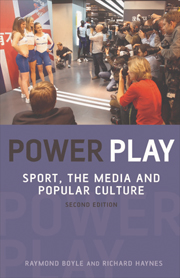Book contents
- Frontmatter
- Contents
- Miscellaneous Frontmatter
- Preface
- Acknowledgements
- 1 Sport, the Media and Popular Culture
- 2 All Our Yesterdays: A History of Media Sport
- 3 A Sporting Triangle: Television, Sport and Sponsorship
- 4 Power Game: Why Sport Matters to Television
- 5 Who Wants to Be a Millionaire? Media Sport and Stardom
- 6 The Race Game: Media Sport, Race and Ethnicity
- 7 Playing the Game: Media Sport and Gender
- 8 Games Across Frontiers: Mediated Sport and National Identity
- 9 The Sports Pages: Journalism and Sport
- 10 Consuming Sport: Fans, Fandom and the Audience
- 11 Conclusion: Sport in the Digital Age
- Bibliography
- Index
8 - Games Across Frontiers: Mediated Sport and National Identity
Published online by Cambridge University Press: 05 August 2013
- Frontmatter
- Contents
- Miscellaneous Frontmatter
- Preface
- Acknowledgements
- 1 Sport, the Media and Popular Culture
- 2 All Our Yesterdays: A History of Media Sport
- 3 A Sporting Triangle: Television, Sport and Sponsorship
- 4 Power Game: Why Sport Matters to Television
- 5 Who Wants to Be a Millionaire? Media Sport and Stardom
- 6 The Race Game: Media Sport, Race and Ethnicity
- 7 Playing the Game: Media Sport and Gender
- 8 Games Across Frontiers: Mediated Sport and National Identity
- 9 The Sports Pages: Journalism and Sport
- 10 Consuming Sport: Fans, Fandom and the Audience
- 11 Conclusion: Sport in the Digital Age
- Bibliography
- Index
Summary
It is a stark dichotomy that sport, the battlefield where casualties are measured only in bruised egos, is also asked to be a healing agent. It is supposed to unite disparate cultures, religions and political regimes, and sometimes it does. But, more often, it does no more than temporarily bring them together, allowing for the possibility that enemies might understand each other a little better, or at least stop hating.
(Sports writer Kevin Mitchell, ‘Why I fear the dragon's claws at my throat’, Observer Sport, 3 August 2008)Introduction
With its visibility and focus on symbols, winning, competition, partisan fans – and in team games the necessity of collective struggle – few other cultural forms lend themselves as easily as sport to being used as an indicator of certain national characteristics and, by extension, of being representative of a national identity. Examples include examining how the Gaelic games of hurling or football typify Irish character (Humphries, 1996, 2007); contrasting English and Italian cultural life through an analysis of their differing footballing cultures (Vialli and Marcotti, 2007); noting the integral position of football in Scottish culture (Cosgrove, 1998; Giulianotti, 2005a) or the extent to which sports such as cricket or rugby have come to symbolize a particular aspect of Englishness (Paxman, 1998; Marqusee, 2001; Tuck, 2003). The ritual and ceremony of sport – particularly national and international sport – carry with them a symbolic significance which far outweigh sport's importance as organized play.
- Type
- Chapter
- Information
- Power PlaySport, the Media and Popular Culture, pp. 144 - 163Publisher: Edinburgh University PressPrint publication year: 2009



